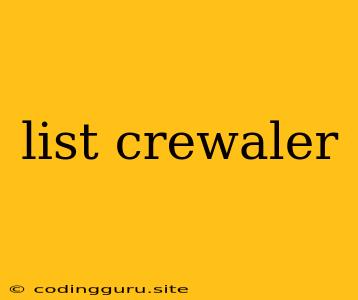What is a List Crawler?
A list crawler is a type of web crawler specifically designed to extract data from lists found on web pages. This is particularly useful when you need to gather information from websites that present data in a list format.
Imagine you're running a market research project and need to collect contact information from companies listed on a directory website. Manually copying and pasting this data would be tedious and time-consuming. A list crawler can automate this process by extracting the desired data from the list elements on the webpage.
Why Use a List Crawler?
- Automation: Automate data extraction from lists, saving you time and effort.
- Scalability: Extract information from large lists, even spanning multiple pages.
- Consistency: Ensure accurate and consistent data extraction, avoiding human errors.
- Data Analysis: Prepare data for further analysis and insights.
How Does a List Crawler Work?
A list crawler uses web scraping techniques to analyze web pages and identify lists. It typically involves the following steps:
- Website Selection: Choose the target website and list you want to extract data from.
- HTML Parsing: The crawler analyzes the website's HTML structure to locate list elements (e.g.,
<ul>,<ol>,<li>). - Data Extraction: The crawler extracts the desired data from within the list elements, such as text content, URLs, or other attributes.
- Data Organization: The extracted data is organized and stored in a desired format, such as a spreadsheet or database.
Types of List Crawlers
List crawlers can be categorized based on their implementation:
- General-Purpose Crawlers: These are versatile tools that can extract data from various types of lists and websites.
- Specialized Crawlers: These are designed for specific types of lists, such as product lists, job listings, or news articles.
Implementing a List Crawler
You can implement a list crawler using various programming languages and tools, including:
- Python: Popular for web scraping with libraries like BeautifulSoup and Scrapy.
- Node.js: Offers libraries like Cheerio and Puppeteer for HTML parsing and web scraping.
- PHP: Commonly used for web development with libraries like DOMDocument for HTML parsing.
Best Practices for List Crawlers
- Respect Website Terms of Service: Always adhere to the website's terms of service and avoid excessive crawling.
- Rate Limiting: Implement rate limiting to prevent overloading the target server.
- Data Cleaning: Clean the extracted data to remove irrelevant information and ensure consistency.
- Error Handling: Implement robust error handling mechanisms to handle unexpected website changes or data inconsistencies.
Examples of List Crawler Applications
- E-commerce Price Comparison: Gather product prices from multiple online retailers.
- Job Search: Collect job listings from different job boards.
- News Aggregation: Extract news articles from various news websites.
- Social Media Monitoring: Collect user posts and comments from social media platforms.
- Market Research: Analyze data from industry directories and websites.
Conclusion
A list crawler is a powerful tool for extracting information from lists on web pages. By automating this process, you can save time and effort, gain valuable insights from large datasets, and improve data analysis workflows. However, it's essential to use list crawlers responsibly and ethically, respecting website terms of service and avoiding excessive crawling.
